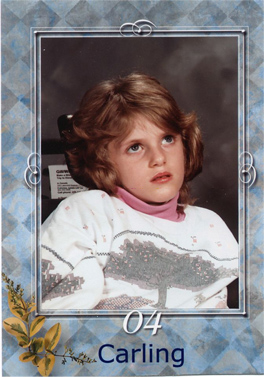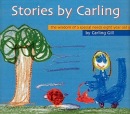
Carling
Carling was born on August 28, 1995. She had her first seizure in July 1998 and, after two more seizures, was referred by her family doctor to specialists at McMaster University Medical Centre. This began an eighteen-month pursuit of a diagnosis.
During the time when her parents were seeking a diagnosis, Carling saw innumerable specialists and health professionals. She was always very brave and became so experienced at giving blood samples that she assisted the technicians. Meanwhile, her symptoms became progressively more pronounced; she was almost continuously having absence seizures, which caused her to lose her balance and fall every 45 seconds.
The family switched her primary care to Sick Kids’ hospital in Toronto, and in January 2000, Carling was diagnosed with Late Infantile NCL, using biopsies of muscle, skin and eye tissues. Devastating as the diagnosis was to her parents, it was also a relief. They no longer had to invest their energy in searching for a diagnosis – they could fully focus on the disorder and its effects on Carling.
From the very start, Diane and John have maintained a positive attitude. When they informed their family and friends of Carling’s diagnosis, they asked not for pity or sympathy, but rather positive thoughts and energy, on which they could build.
Since traditional medicine offered neither a treatment nor a cure for NCL, Diane and John looked to alternative medicine and have worked extensively with a naturopathic doctor and other natural health practitioners.
Diane describes NCL as an unusual disorder because it takes functionality away so slowly that it is not always noticed at the time. Nevertheless, it slowly diminished Carling’s capacity to perform basic body functions. At the time of her death in April 2004, Carling was unable to speak, but was aware and understood what was being said to her. She was able to walk with assistance, moving her own legs. In the summer of 2001, she got a wheelchair, which allowed for greater mobility outside the home.
Carling had a gastric tube (G-Tube) which allowed for feeding directly into the stomach. She was able to eat some foods by mouth, but the wonderful thing about the G-Tube was that it allowed Carling to get regular food, pureed until smooth, as well as adequate fluids and medicine. (She could also take more bitter remedies – such as some of the Chinese herbal tinctures without having to taste them!)
Carling went to school when she was well and was in grade 2. With her educational assistant, she used a hand-over-hand technique to draw and print the alphabet. She had a stander device, which supported her in standing in a small group setting with the other children, and promoted her health as well as independence and self-confidence.
She died in April 2004.
Stories by Carling
One of Carling's wishes was to
write a book, and she did it! The book has been published and you can
find out here about getting your own
copy.

|